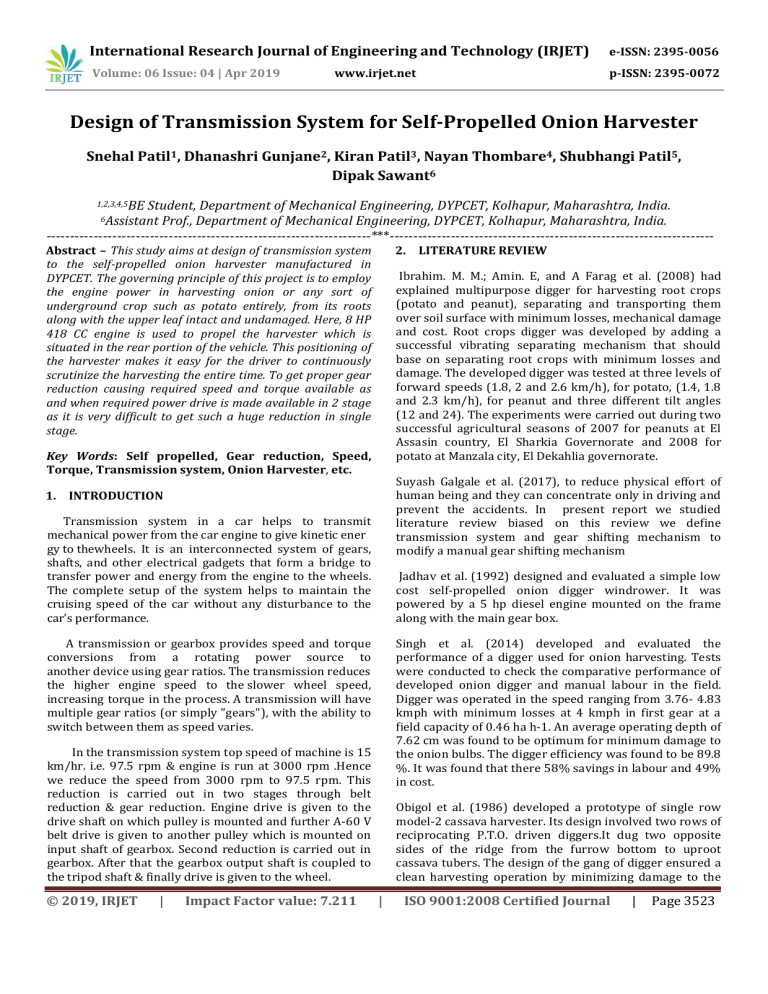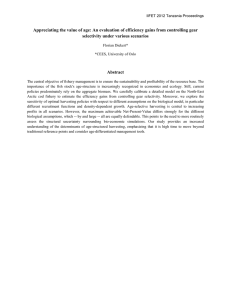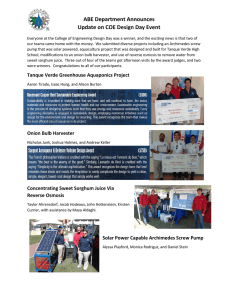IRJET-Design of Transmission System for Self-Propelled Onion Harvester
advertisement

International Research Journal of Engineering and Technology (IRJET) e-ISSN: 2395-0056 Volume: 06 Issue: 04 | Apr 2019 p-ISSN: 2395-0072 www.irjet.net Design of Transmission System for Self-Propelled Onion Harvester Snehal Patil1, Dhanashri Gunjane2, Kiran Patil3, Nayan Thombare4, Shubhangi Patil5, Dipak Sawant6 1,2,3,4,5BE Student, Department of Mechanical Engineering, DYPCET, Kolhapur, Maharashtra, India. Prof., Department of Mechanical Engineering, DYPCET, Kolhapur, Maharashtra, India. ---------------------------------------------------------------------***--------------------------------------------------------------------6Assistant Abstract – This study aims at design of transmission system to the self-propelled onion harvester manufactured in DYPCET. The governing principle of this project is to employ the engine power in harvesting onion or any sort of underground crop such as potato entirely, from its roots along with the upper leaf intact and undamaged. Here, 8 HP 418 CC engine is used to propel the harvester which is situated in the rear portion of the vehicle. This positioning of the harvester makes it easy for the driver to continuously scrutinize the harvesting the entire time. To get proper gear reduction causing required speed and torque available as and when required power drive is made available in 2 stage as it is very difficult to get such a huge reduction in single stage. 2. LITERATURE REVIEW Ibrahim. M. M.; Amin. E, and A Farag et al. (2008) had explained multipurpose digger for harvesting root crops (potato and peanut), separating and transporting them over soil surface with minimum losses, mechanical damage and cost. Root crops digger was developed by adding a successful vibrating separating mechanism that should base on separating root crops with minimum losses and damage. The developed digger was tested at three levels of forward speeds (1.8, 2 and 2.6 km/h), for potato, (1.4, 1.8 and 2.3 km/h), for peanut and three different tilt angles (12 and 24). The experiments were carried out during two successful agricultural seasons of 2007 for peanuts at El Assasin country, El Sharkia Governorate and 2008 for potato at Manzala city, El Dekahlia governorate. Key Words: Self propelled, Gear reduction, Speed, Torque, Transmission system, Onion Harvester, etc. Suyash Galgale et al. (2017), to reduce physical effort of human being and they can concentrate only in driving and prevent the accidents. In present report we studied literature review biased on this review we define transmission system and gear shifting mechanism to modify a manual gear shifting mechanism 1. INTRODUCTION Transmission system in a car helps to transmit mechanical power from the car engine to give kinetic ener gy to thewheels. It is an interconnected system of gears, shafts, and other electrical gadgets that form a bridge to transfer power and energy from the engine to the wheels. The complete setup of the system helps to maintain the cruising speed of the car without any disturbance to the car’s performance. Jadhav et al. (1992) designed and evaluated a simple low cost self-propelled onion digger windrower. It was powered by a 5 hp diesel engine mounted on the frame along with the main gear box. A transmission or gearbox provides speed and torque conversions from a rotating power source to another device using gear ratios. The transmission reduces the higher engine speed to the slower wheel speed, increasing torque in the process. A transmission will have multiple gear ratios (or simply "gears"), with the ability to switch between them as speed varies. Singh et al. (2014) developed and evaluated the performance of a digger used for onion harvesting. Tests were conducted to check the comparative performance of developed onion digger and manual labour in the field. Digger was operated in the speed ranging from 3.76- 4.83 kmph with minimum losses at 4 kmph in first gear at a field capacity of 0.46 ha h-1. An average operating depth of 7.62 cm was found to be optimum for minimum damage to the onion bulbs. The digger efficiency was found to be 89.8 %. It was found that there 58% savings in labour and 49% in cost. In the transmission system top speed of machine is 15 km/hr. i.e. 97.5 rpm & engine is run at 3000 rpm .Hence we reduce the speed from 3000 rpm to 97.5 rpm. This reduction is carried out in two stages through belt reduction & gear reduction. Engine drive is given to the drive shaft on which pulley is mounted and further A-60 V belt drive is given to another pulley which is mounted on input shaft of gearbox. Second reduction is carried out in gearbox. After that the gearbox output shaft is coupled to the tripod shaft & finally drive is given to the wheel. © 2019, IRJET | Impact Factor value: 7.211 Obigol et al. (1986) developed a prototype of single row model-2 cassava harvester. Its design involved two rows of reciprocating P.T.O. driven diggers.It dug two opposite sides of the ridge from the furrow bottom to uproot cassava tubers. The design of the gang of digger ensured a clean harvesting operation by minimizing damage to the | ISO 9001:2008 Certified Journal | Page 3523 International Research Journal of Engineering and Technology (IRJET) e-ISSN: 2395-0056 Volume: 06 Issue: 04 | Apr 2019 p-ISSN: 2395-0072 www.irjet.net harvested tubers. It left a well pulverized row with good tilth. The harvester operated at a forward speed of about 2.5 kmh-1 to 4 kmh-1and harvesting rate was 0.25 to 0.4 ha h-1. Objective of research is to test the performance of the mini tractor operated coleus digger. Mohamed et al.(2019) worked on that the potato peeling machine consists of seven parts, main frame, peeling drum, hopper, collection basin, waste remover, water supplying systems, and power transmission. The machine was evaluated using different potato bulb sizes (small, medium & large). A mixed sample of different sizes was also tested. The evaluation process was conducted between1000 and 1440rpm drum rotational speeds , three different peeling residence times (10,15 and 20seconds) and two different batch loads (1 and 1.5 kg). The optimum peeling efficiency of 52.55%, 87.99% and98% was obtained at 10, 15 and 20 seconds respectively and at recommended drum speed of 1440 rpm. The average value of the mean field capacity of the potato peeler obtained from the trials for small, medium, large and mixed sizes were 0.092kg/sec, 0.093kg/sec ,0.091kg/sec and 0.093kg/sec respectively. Generally the mean field capacity of the potato peeler obtained from the trials for small, medium, large and mixed sizes were 0.092kg/sec (333.7164 kg/hr). The estimated costs of potato peeling machine including the machine costs, the raw materials, and labor cost was 3,252.65EB. Sungha Hong et al. (2014) did experiment for evaluating harvesting performance that was performed for development Welsh onion harvester in an actual Welsh onion farm. Harvest performance evaluated at tractor running speed of 5.0 cm/s, 11.4 cm/s, 15.8 cm/s by comparing operating efficiency, harvest rate & damage rate of Welsh onion harvester & it is believed to improve labour productivity & cultivation environment bt mechanization of harvesting process that is currently associated with largest amount of labour hour. Gavino et al.(2018) study yielded that an onion harvester attached to the locally available hand tractor was designed and fabricated to harvest onions with a field capacity of 0.086 ha per hour and a field efficiency of 80.52%. With this machine, the required labor for harvesting onions was reduced from 122 to 69 man-hours per ha. The computed custom rate of digging and windrowing onions per hectare using the machine is PhP1,850, resulting to a decrease of about P3,300 per ha for the complete harvesting operations 3. MATERIALS & METHODS Objectives of this study is design of transmission system for the self-propelled onion harvester that is design and fabricated in DYPCET, Kolhapur, Maharashtra. (digging to bagging of onions) when compared to manual harvesting. Farmers who had witnessed the field testing and demonstration perceived that this machine, when fully developed and made available in the market, will be of great help to onion farmers. KOEL CC418 Diesel engine, 8HP @ 3000 rpm. The main aim of work was to limit the speed of the harvester to 15 km/hr that is 97.5 rpm so to utilize and design a system which will give higher reduction as per calculation. Bendix et al. (2001) studied that mechanical harvester for harvesting, topping and Sacking bulb crops, Such as onions. The harvester extracts the onions from the ground and transports them rearward to a cutting assembly by conveyor Systems that drop out Small onions, dirt, rocks and debris. The cutting assembly comprises a Set of elongated cutting blades positioned to cooperatively accept and sever the leaves and roots from the bulb. The offal drops away from the harvester to the ground by manner of gravity. After cutting, the onions are transported through an inspection assembly for inspection, Sorting, grading and further distribution. The onions are then transported rear ward to a sacking assembly for placing the onions into Sacks, to a chute device returning the onions to the ground or to a conveyor System transferring the Onions to an adjacent vehicle. Platforms on the sides and ends of the harvester facilitate the above operations. © 2019, IRJET | Impact Factor value: 7.211 Overall reduction i.e. from 3000 rpm to 97.5 rpm is very high for achieving in single stage. So this reduction is achieved in two stage. For first stage reduction A60 V Belt Drive (Open) is used in which 3:1 reduction is taken. And for second stage Gearbox of having 3 forward gears and 1 reverse gear is used. Gearbox reduction in top gear is 8.9:1 which will limit the speed under 97.5 RPM. The gearbox output shaft is coupled to the tripod shaft which is finally connected to wheel. Following product dimensions taken into consideration: • • • • • • • • | Engine make/model: Kirloskar Oil Engines Ltd. (KOEL) Type: Vertical Single Cylinder Diesel Engine,418CC Rating: 8hp@3000rpm Max Torque: 19N.m @ 2000rpm High Idle: 3300rpm Dry Weight: 44 kg Dimension: 470x310x490 cm Fuel tank capacity: 3.5L ISO 9001:2008 Certified Journal | Page 3524 • • International Research Journal of Engineering and Technology (IRJET) e-ISSN: 2395-0056 Volume: 06 Issue: 04 | Apr 2019 p-ISSN: 2395-0072 www.irjet.net • Starting method: Rope start Decompression lever The force available at the constant between the drive wheels tyres and road is known as ‘tractive effort’. The ability of the drive wheels to transmit this effort without slipping is known as ‘Traction’. Hence usable tractive effort never exceeds traction. 4. CALCULATION PERFORMANCE CHARACTERISTICS CALCULATIONS: (THEORETICAL) • Traction and tractive Effort For achieving speed of 15 Km/Hr, we require wheels to rotate at 97.5 rpm. Rolling Resistance The magnitude of rolling resistance depends mainly on, a. The nature of road surface b. The types of tyre viz. pneumatic or solid c. The weight of the vehicle d. The speed of the vehicle a) b) c) d) e) f) g) TE =Mean Engine torque = 19 N.m ŋt = Overall Transmission efficiency = 0.85 EN = Engine speed = 3000rpm WN= Wheel Speed =15 Km/hr. r = Radius of tyre = 409 mm = 0.409m Tw =Torque at wheels F=Tractive Effort Tw = Rolling Resistance = Rr = KW Tw= Where, Tw = 496.92 N-m W = Weight of vehicle = 570 kg Tractive Effort (F): K = constant of rolling resistance F= = 0.18 (for loose sand roads) Rr = 570 x 9.81 x 0.18 F= Rolling Resistance (Rr) = 1006.5N • F = 1214.96 N Air Resistance When the tractive effort F>R, the total resistance on level road, the surplus tractive effort is utilized for acceleration, hill climbing and draw-bar pull. As per above calculation F > R, hence vehicle can easily propel. Air Resistance = 𝐶𝑑𝜌𝑉2𝐴 Where, • Acceleration Cd = Coefficient of Drag Here acceleration for top gear is calculated 𝜌 = Density of air a= V = Velocity a= A = Area a = 0.365 m/s2 • | Gradeability The maximum percentage grade, which a vehicle can negotiate with full rated condition, is known as ‘Gradeability’. Air Resistance = 5.96N © 2019, IRJET …… (For 3rd Gear) Impact Factor value: 7.211 | ISO 9001:2008 Certified Journal | Page 3525 International Research Journal of Engineering and Technology (IRJET) e-ISSN: 2395-0056 Volume: 06 Issue: 04 | Apr 2019 p-ISSN: 2395-0072 www.irjet.net Sample Calculation for 3rd Gear Gradeability = Torque = Engine Torque * Total Reduction * Transmission Efficiency = Torque = 19 * 26.97* 0.85 Gradeability = 36.57% • Torque = 435.57 N-m ……. (For 3rd Gear) Tractive Effort = Torque at wheel / Radius of wheel Drawbar Pull Tractive Effort = 496.92 / 0.409 When the excess power is fully utilized for pulling extra load attached to vehicle then, Tractive Effort = 1214.96 N RPM of wheel = (Engine RPM / Total Reduction) * Transmission Efficiency Drawbar Pull = Tractive Effort – Road Resistance =F–R RPM = (3000 / 26.97) * 0.85 = 1214.96 – 1006.5 RPM = 94.55 = 208.46 N Drawbar Pull = 21.25 Kg Speed ……. (For 3rd Gear) GEAR BOX REDUCTION CALCULATION FOR TORQUE AND RPM (ACTUAL):Engine Pulley = Input Pulley = 80 mm Gear Box Pulley = Output Pulley = 240 mm Pulley Reduction = = Pulley Reduction = 3 Total Reduction = Gear Box Reduction * Pulley Reduction For RPM calculation and Torque Calculation 15% Transmission Losses are considered. Table-1 Gear Box Reduction Calculation No. of Gear Gear Box * Pulley Total Reduction For 1st Gear 26.43*3 79.29 For 2nd Gear 13.42*3 40.26 For 3rd Gear 8.99*3 26.97 For Reverse gear 27.05*3 81.15 © 2019, IRJET | Impact Factor value: 7.211 Table -2 Gear Box Calculation | Gear Ratio RPM Torque (N-m) Speed (Km/hr) 1 79.29 32.16 1280.53 4.96 2 40.26 63.34 650.19 9.77 3 26.97 94.55 435.57 14.58 Reverse 81.15 31.42 1310.57 4.84 ISO 9001:2008 Certified Journal | Page 3526 International Research Journal of Engineering and Technology (IRJET) e-ISSN: 2395-0056 Volume: 06 Issue: 04 | Apr 2019 p-ISSN: 2395-0072 www.irjet.net 5. LAYOUT [3] Jadhav, R V & Gharte (1992) Design, Development & Performance evaluation of an onion digger windrower AMA,26(2) 35-38 [4] Singh, Mahesh Chand (2014) Develop & Performance evaluation of digger for harvesting onion (Allium cepaL) Internat. J. Agric. Engineering., 7(2).391-394 [5] Obigol, E. U. (1986) Single row Model – 2 cassava harvester AMA. 22(2). 63-66 [6] Sungha Hong, (2014) Development of Welsh onion Harvester for Tractor, SUWAN, Republic of Korea [7] HF Gavino, (2018) Development of locally made Power Tiller Driven Onion Harvester1 [8] Bendix (2001), Mechanical harvester for harvesting bulb crops. United State Patent Fig 1. Overall Layout of Transmission System 6. CONCLUSION This paper presents theoretical calculations for power drive used for self-propelled onion harvester. In this work we considered minimum required speed for harvesting onion properly without damaging onion bulb and its leaf. In that future work is smooth moving and optimization of size. Torque and speeds obtained are more than sufficient for harvesting onion. Further speed and torque may be reduced to improve efficiency of safe and good conditioned onion harvested. REFERENCES [1] Ibrahim, M. M., Amine, E. and Farag, A. (2008), Developing multi-purpose digger for harvesting root crops, Misr. J. Agric. Eng. Dept Fac. Of Agic., Mansoura Univ. [2] Suyash Galgale, Prathamesh Deore, Ketan Pardeshi (2017) Automobile Transmission Systems, University of Pune, Nasik, India © 2019, IRJET | Impact Factor value: 7.211 | ISO 9001:2008 Certified Journal | Page 3527



